
Technology
Good - Bad - Different

More Robots Are Coming, Whether You Like It Or Not: "News that efficient fast-food robots are entering the market have sent shudders through advocates of a guaranteed minimum wage. What’s the sense of aiming for a career in flipping burgers if those jobs are poised to go the way of buggy-whip makers and slide-rule manufacturers? Technological innovation is menacing employment."
This is the inevitable consequence of the $15/hour minimum wage. Robots do not require Obamacare coverage, maternity leave or vacation days.
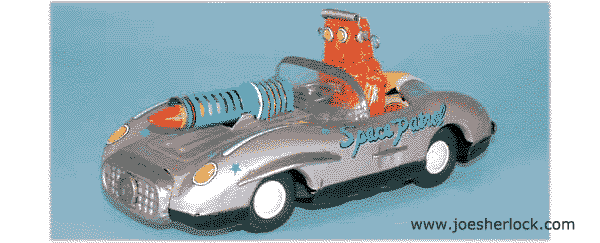
Robert Kuttner of the 'American Prospect' noted that "robots have indeed eliminated a great deal of factory work and are rapidly moving on to product design, medical diagnostics, research, teaching, accounting, translating, copy editing, and a great deal more. Once-secure professions are no longer safe. From that, many economists conclude that we may just have to adjust to a high plateau of unemployment."
So, how do you keep from being replaced by a robot? Simple. Improve your skills so that you can perform tasks not easily duplicated by robots: one-on-one personal selling, jobs which require creative and/or strategic thinking, etc. (posted 6/5/15, permalink)
Ancient Ultra High Tech: 37 years ago, we were amazed by this family 'photo' taken with a video camera which fed into an IBM Selectric typewriter:

It was taken during a demonstration at Philadelphia's wonderful Franklin Institute when we visited in 1977. (posted 8/13/14, permalink)
'Book Review: 'Big Data: A Revolution That Will Transform How We Live, Work, and Think' by Viktor Mayer-Schonberger and Kenneth Cukier.
The engineer part of me has always searched for data. Early in my career, I used to say to my fellow engineers, "Theorize all you want but it's all bullshit until you have empirical results." There were occasions when I ran tests, collected data and blew people's pet theories, rules of thumb and gut feelings out the window. Unfortunately, some of these erroneous assumptions had been authored by my superiors who were not pleased.
Data is used to spot trends so you can do something about them - take commercial advantage of a growing market, buy airline tickets at the best price, predict traffic jams and reroute vehicles. This is only possible because of the lower cost of computing power. The authors point out that, in 1986, "around 40% of the world's general-purpose computing power took the form of pocket calculators, which represented more processing power than personal computers at the time."
Technology has made the collection of data cheap and easy. This book shows the dramatic impact it will have on the economy, science, and society at large. 'Big Data' refers to our ever-expanding ability to process vast collections of information, analyze it almost instantly, and draw conclusions - often surprising ones - from it ... (more >>>)
 Technology Is Wonderful ... except when it's a pain in the ass. In the last century, people used keys to operate their cars - locking and unlocking doors, turning on the ignition, accessing the trunk. Car keys typically lasted 20 years or so, eventually wearing down to the point where they were unusable. Technology Is Wonderful ... except when it's a pain in the ass. In the last century, people used keys to operate their cars - locking and unlocking doors, turning on the ignition, accessing the trunk. Car keys typically lasted 20 years or so, eventually wearing down to the point where they were unusable.
In the 21st Century, electronic proximity keys have become fashionable. These smart keys cause the vehicle to 'recognize' you as you approach your vehicle, turning on interior lights and/or puddle lights in the side mirrors. Touch the door handle and the car unlocks - a very convenient feature when it's dark and rainy.
Unfortunately, proximity keys are battery powered and the little discs die without much warning. Once they falter, it's Get Thee To A Dealer Posthaste. Otherwise, you can't lock, unlock or start your vehicle. Yes, there is a little juice in the RFID chip but it only buys a small amount of time.
Both of our daily drivers have smart keys and the batteries swoon and go into electronic death rattle mode every year or two. Recently, my key for my wife's car began its short journey into electron oblivion, so I headed to the local Toyota dealer and had a new battery installed.
I never have to do this with my 1939 Plymouth. (posted 11/19/12, permalink)
I Love Technology, Except When I Hate It: Yeah, it's nice to be able to order obscure stuff online and to use Google maps to find unfamiliar addresses but there's soooo much stuff I don't know how to do. I'm old and just not that interested in learning a bunch of ever-changing technology. I think that this Dilbert cartoon captures me:

None of my friends my age have blogs, so they think that because I do I have Mastered Technology. No way. I feel so lost, especially when it comes to all the new stuff: Twitter, Linked-In (I'm retired and don't want to be Linked In to any business networks), Facebook (a wonderful resource for identity thieves, I'm told) and all other social networks.
I'm of the opinion that 'friending' someone on Facebook is just a cheapskate's way of not picking up bar tabs. If you really want to be my friend, you'd buy me a drink.
My 2004 cell phone doesn't take pictures, allow for texting or app downloading. I don't care. I only carry it for emergencies. I never check voice messages and have it turned off 99.9% of the time. I don't need to be in touch every available second.
I'm just happy that phones no longer have rotary dials. (posted 3/22/12, permalink)
Rabbit Test: While going through some old photographs, I found an item that my mom had kept for sentimental reasons.
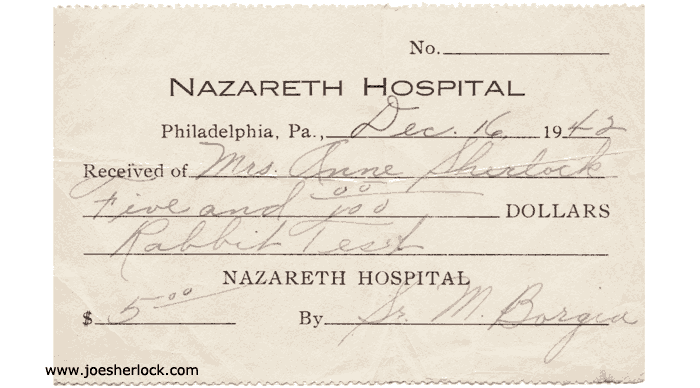
It was a receipt for the pregnancy test which verified the presence of ... ummmm ... soon-to-be me. It was done at a hospital and cost five bucks. That translates to almost $67 in today's money. But, because of technology advances, you can now buy a do-it-yourself pregnancy tester for a buck in almost any Dollar Store. And get an answer without bumping off a harmless little bunny.
The hospital nun who made out the receipt, Sister M. Borgia SSJ, lived a long - and hopefully happy - life and died in 2004 at age 93. (posted 7/5/11, permalink)
The Future Has Arrived: Toyota has announced plans to create Toyota Friend, a private social networking service that will let cars "tweet" their drivers when they need servicing.
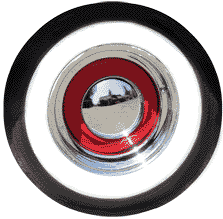 In September, 1999, I wrote that, in 2006, "Every morning at 2:00 am, your car will run complete mechanical diagnostics on itself, including tire pressure as well as tire and brake wear. In September, 1999, I wrote that, in 2006, "Every morning at 2:00 am, your car will run complete mechanical diagnostics on itself, including tire pressure as well as tire and brake wear.
If there's a problem, your car will send you e-mail and tell you where it hurts."
Not all my predictions come true.
In the same article, I forecasted that, in 2009, Starbucks would "turn all of their coffee houses into tire stores" because of the "demise of those high-priced, pseudo-gourmet coffee drinks."
"While they will disdainfully sell you 'regular' tires if you so demand, they would rather sell you some of their designer tires - custom-molded while you wait - in special colors to complement the color of your car.
Try the Aruban-blue Neoprene blend."
Hey, it could still happen. (posted 5/25/11, permalink)
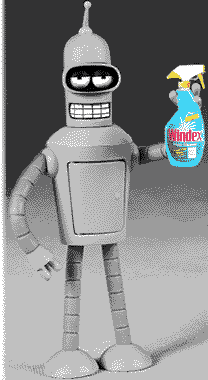 Robo-Clean: Windoro, the window-cleaning robot, consists of two modules that go on opposite sides of the window and hold each other using permanent magnets. Robo-Clean: Windoro, the window-cleaning robot, consists of two modules that go on opposite sides of the window and hold each other using permanent magnets.
Its creators say that it's designed for cleaning windows at homes and stores.
One of the robot's modules works as the navigation unit. It uses accelerometers to navigate and bump sensors to detect obstacles and window frames.
The other is the cleaning unit, which has four spinning microfiber pads and a reservoir that dispenses detergent.
What I want to know is when will someone offer a smaller device that works on car windows? Everyone knows that the hardest part of car washing is getting the windows clean. Particularly the #$%@! inside windows.
That's my opinion, anyway.
James Lileks has written about the frustration of trying to clean clear glass of all kinds: "You clean the window, and it looks great, and then the sun hits it just right and it looks like you washed the window with used bathwater and wiped it off with moist drier lint.
If the cleaning fluid label says 'Streak Free', I now believe this means "Streaks provided free of charge.""
What we need is a Windshield Roomba.
Set it up at night and by morning - Viola! - clean windows. And, you could use it on all your cars.
I know I'd buy one. (posted 1/28/11, permalink)
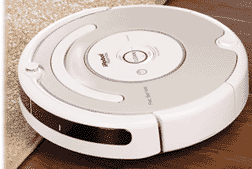 The Sucky Life: My wife's Roomba - the robot vacuum cleaner shaped like a German World War I land mine - stopped working ten days ago. It was hell trying to get any online customer help from the maker, iRobot, but I finally got through to a sensible customer service person by phone. He determined that the Roomba needed a new battery, which I then ordered. The Sucky Life: My wife's Roomba - the robot vacuum cleaner shaped like a German World War I land mine - stopped working ten days ago. It was hell trying to get any online customer help from the maker, iRobot, but I finally got through to a sensible customer service person by phone. He determined that the Roomba needed a new battery, which I then ordered.
The customer rep telephoned later to tell me that he were also sending a "software upgrade kit" for the Roomba.
When we married 44+ years ago, my wife's Uncle Paul gave us a Hoover upright vacuum cleaner. We still have it and use it regularly. Over the years, I have replaced belts, bags, bulbs, bolts and even the handle, which suffered metal fatigue from so many years of use, but the old Hoover has never needed a "software upgrade."
Sometimes, I think progress sucks. But then, so does a good vacuum cleaner.
My parents bought a new Lewyt vacuum in 1953. I now have it in my garage and sometimes use it for cleaning car interiors. It still works and the canister is still shiny 57 years later. Details on a Lewyt vacuum cleaner just like mine can be found here. There are six pages of near-obsessive photographs, too.
Meanwhile, the Roomba now appears to be fixed. Mirabile dictu!
A new battery arrived last Friday and I installed it Saturday morning. Then I charged up the little robot and sent it on its way. It moved all over the downstairs humming, spinning and staggering through various rooms, like a tipsy Kennedy at a D.C. pickup bar. When the battery was nearly exhausted, the Roomba found its way back to the charger dock and recharged itself.
The promised 'software' arrived Monday in the form of Osmo, a little white puck the size of a fancy motel soap. I followed the instructions, jacked it into the Roomba and it appeared - based on the behavior of the blinking lights - that the upgrade was successful.
Osmo is now winging its way back to iRobot's Lancaster PA service center in the postpaid return padded envelope. (posted 10/13/10, permalink)
Chugging Along: During the big storm which swept Great Britain in December 2009, the Tornado, a Pacific (4-6-2) class steam locomotive, "was the only engine running in southeast England. The remainder, electrics, had been disabled by the cold." I wonder if it's because workers have forgotten how to clean ice from overhead wires.

Sometimes old technology is best. (posted 1/13/10, permalink)
It's Magic: My wife bought me an early Christmas gift - an iPod nano. This device, smaller than a business card, can hold over 4,000 songs in its 16 gigabyte memory. (I have less than 1,400 songs in my iTunes library; I'm not sure that there are 4,000 songs I'd want to listen to.)
The nano also has a video camera with a tiny, pinhole-sized, fixed-focus lens which shoots in widescreen format. A built-in mic captures audio.
In addition to the standard ear pods, my wife gave me an adapter so that I can play the iPod audio through my car's speaker system. As well as a tabletop speaker dock so that I can play it like a table radio.
I tried out the video function by shooting my train layout. Everything was filmed handheld in ambient light. I took the raw footage and edited it with iMovie (on my recently-purchased iMac computer). I created a background music track using Apple's GarageBand. Then I published the video on YouTube:
PS: I had never used the iMovie or GarageBand software before and this is my first posting on YouTube. If you're over 60, all new technology is a form of magic. (posted 12/15/09, permalink)
"Giant Robot Imprisons Parked Cars": This headline is soooo compelling that I would have posted it anyway even if the story was lame. But it happens to be a very interesting tale.
The robot that parks cars at a city-owned parking garage in Hoboken, New Jersey, trapped hundreds of vehicles last week for several days. But it wasn't the technology car owners had to curse, it was the terms of a software license.
The parking structure is owned by the city; the software, by Robotic Parking of Florida.
In the course of a contract dispute, the city had police escort the Robotic employees from the premises a few days before the contract between both parties was set to expire. What the city didn't understand or perhaps concern itself with, is that they sent the company packing with its manuals and the intellectual property rights to the software that made the giant robotic parking structure work.
How pissed would you be if your car was one of those impounded because of some bureaucrat's stupidity? (posted 8/9/06, permalink)
Backward Compatibility: A friend of mine tried to buy a book online. He uses a seven year-old computer and cannot do any further browser upgrades. He was unable to transact at Overstock.com and A-1 Books. I recommended Amazon.com; it always worked when I had an older computer. Success.
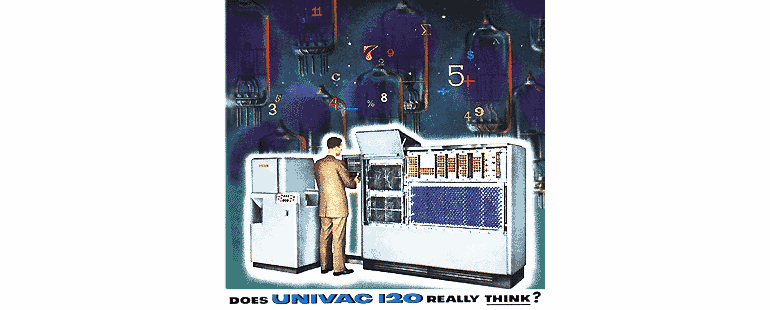
I've criticized some aspects of Amazon's business model, but they've certainly got it right when it comes to providing a shopping site which is user-friendly to older browsers. Too many people with websites assume that everyone has a new computer. They construct sites which have little 'backward compatibility.' This is incredibly stupid. Imagine building a carwash that can't clean cars more than five years old! Not everyone runs out and buys a new car every few years. Or a new computer.
There are many good potential customers with substantial disposable incomes who operate on the principle, "If it ain't broke, don't fix it." They drive older cars and run older browsers on aging but workable computers. Turn away these customers at your own risk.
That's today's business lesson. (permalink)
What's In A Name? In 1959, the Guide Lamp Division of General Motors (now a separate company known as Guide Corp.) developed the Twilight Sentinel - a sensor system which automatically turned the headlights off and/or on at dusk/sunrise. It was first offered as an option on 1960 Buick models.

This is not to be confused with Autronic Eye headlamp control, introduced by GM in 1952. A phototube atop the left end of the dashboard, just inside the windshield, dimmed the lights upon the approach of an oncoming car and cycled back to bright when the traffic had passed. It was offered on Oldsmobile and Cadillac cars. But automatic headlights tended to flicker erratically in response to minute fluctuations of light. By 1959, it was improved and renamed "Guide-Matic Power Headlight Control."
Ford offered a similar device in the 1950s. I once owned one of the few Continental Mark IIs equipped with one.
The Twilight Sentinel name is still used by GM. To me, it evokes the image of a uniformed guard outside a hospice. Creepy. (posted 10/19/05, permalink)
The Perfect Gift: You never get what you really want for Christmas or your birthday, do you? My unfulfilled wish - a car that washes itself.
You just know that car companies have the technology to do this. But the Motor Overlords been paid off by the insidious Car Wash Trust. The plans are locked in a large vault in Detroit, along with the gas-from-water formula, the rubber recipe to produce 100,000-mile tire treads and the blueprints for the 600-horsepower, 100 mpg engine. And Harley Earl's cryogenically frozen head. (permalink)
Blue Light Special: I recently got a new cell phone. My old one, an Oki-made GTE model from 1994 - a dull black brick, was on its last legs, kept alive with parts scrounged from my daughter's old GTE. My new one is a small, sleek, rounded Motorola in silver and gray which emits an eerie blue light when activated.
 The blue light is identical to the light emitted by those germ-free toilet seats found in certain gas stations in the late 1940s-early '50s. The horseshoe-shaped seats were spring-loaded and retracted into a UFO-like, white-enameled sheetmetal cocoon when not in use - where they were exposed to a bright blue UV-lamp which "killed all germs." The blue light is identical to the light emitted by those germ-free toilet seats found in certain gas stations in the late 1940s-early '50s. The horseshoe-shaped seats were spring-loaded and retracted into a UFO-like, white-enameled sheetmetal cocoon when not in use - where they were exposed to a bright blue UV-lamp which "killed all germs."
The light leaked out the corners of the shroud, emitting a scary, toilet seat-shaped, ghostly blue glow. I was quite frightened of these devices as a small child and would refuse to use the toilet to the great annoyance of my parents: "Well, you said you had to 'go' and we made a special stop for you. Now you won't go?! Well, mister, you can just suffer and hold it until we get home." Which was fine with me; there were no blue toilet-ghosts in our home bathroom.
I was reminded of those toilet-ghosts every time I had to make copies of drawings on an Ozalid blueprinting machine when I was working as a mechanical engineer; a similar, strange blue light emitted from somewhere in the bowels of the copier.
The charger for my new phone is just a cord with a tiny little box at one end. My old phone had a docking station that looked like it was sized for jump-starting Soviet tanks. The phone company deactivated my old phone remotely (How the hell do they do that?!) and said that I should toss the old phone and charger - part of our throwaway culture.
I didn't. Instead I gently committed their inert remains to the Special Drawer of Obsolete Electronic Items in my roll-top desk. The Drawer is starting to get full, however. Another useless collection which my wife will throw out after I'm dead. Shaking her head and muttering, "Why, in heaven's name, did he keep all this junk?" (posted 6/5/04, permalink)
Senseless Hybrids? Nissan Chief Executive Carlos Ghosn said (in an address to the National Automobile Dealers Association) that building fuel-sipping hybrid vehicles makes little sense in today's world because of their high costs. "They make a nice story, but they're not a good business story yet because the value is lower than their costs." He also poured cold water on hydrogen fuel cell vehicles: "The cost to build one fuel cell car is about $800,000. Do the math and you figure out that we will have to reduce the cost of that car by more than 95 percent in order to gain widespread marketplace acceptance."
I have often felt that hybrid cars are some kind of dead-end transitional technology. Like fax machines. (We are becoming a paperless society - e-mail, JPEGs and FTPs have rendered fax machines unnecessary for transmitting text and graphics - and no one ever developed the technology to fax a hot, ready-to-eat pizza.)
My opinion is that future cars will not be diesel, hybrid or hydrogen. I think we will use internal combustion engines with improved efficiency via deactivated cylinders, improved transmission systems and other technology. Ten years from now, most cars will still use gasoline or a ethanol/gasoline mix. (posted 2/2/05, permalink)
Car Technology Runs Amok: I often exchange correspondence with car friends, mailing them magazine articles, etc. One of my car buddies sent me an article from the April 2004 issue of Automobile magazine. Jamie Kitman - a very knowledgeable writer who has appeared in other car buff mags - pens a column, 'Noise, Vibration and Harshness.'
April's is titled 'Crapulent Luxury' and tells the tale of making an uneventful drive in an economy Mitsubishi from New York to Detroit in order to pick up a luxurious 2004 Jaguar XJ8 sedan. Then things got eventful. Warning lights flashed for no reason.
After a tire blowout on the road, Kitman couldn't change the tire because the factory wrench stripped three of the "cheap, soft and unremovable aluminum glamorizing covers on the lug nuts." The $66,000 Jaguar was hauled away on a flatbed, with an $800 alloy wheel ruined and no replacement in-stock. So, Kitman switched to a BMW 745Li which was also suffered from electronic gremlins. Arriving back in New York, he had to take it to a BMW dealer for repairs.

Kitman's article arrived in the mail along with a separate package from Jaguar USA, urging me to buy a new 2004 XJ8. Dripping with unplanned irony, the package contained an 80-page special report on the technically sophisticated beast, prepared by - guess who? - the staff of Automobile.
After reading Kitman's column about the horrors of the 2004 "advanced" Jaguar, I'm definitely keeping my aging but reliable 1996 XJ6 Vanden Plas. It has never left me stranded.

My straight-six-engined Jag seems every bit as fast as a V-8 Jaguar sedan I test drove. When my Jag reaches 100,000 miles in a few years, I may get the front-end repainted (to eliminate many years of stone chip accumulation) but, at this point, I have no interest in replacing this fine-looking, trustworthy machine with the kind of techno-nightmare described by Kitman.
Mark Phelan of the Detroit Free Press has written about technological overkill: "Cadillac won global praise and international awards for innovative engineering when it introduced infrared night vision on its DeVille sedan a few years ago, but the feature isn't available on the new 2005 STS sedan, and it's not likely to show up on any future Cadillacs. The option, which projects a green image on the car's heads-up display, works just fine, but it turns out buyers just don't care enough about it to shell out an extra $2,250 to see a blurry silhouette of a possum in a roadside ditch." (posted 7/1/04, permalink)
101 Years Difference: In 2004, I visited a Toy Train Operating Society open house at the home of a private individual. On his layout was a 1903 loco - the only known 101 year-old Lionel train that still runs. Even the track is the original. It was obtained from the daughter of the original owner along with the 1903 bill of sale from the Emporium in San Francisco! On Tuesday, I related the story of a Lionel toy train locomotive, purchased in San Francisco in 1903. Lionel was, in those days, a start-up firm located in Lower Manhattan.
 It is difficult to imagine cross-country commerce in the very early 20th Century. Ordering was probably done strictly by mail; telephones were not in wide use and, in any case, there was no coast-to-coast long distance service. Bank wire transfers and credit cards were unheard-of. Mailed bank drafts and letters-of-credit were the primary means of money transfer. There would have been only two shipping options - rail shipment (expensive) or a slow cargo ship around Cape Horn (very slow). There was no Panama Canal yet. Offering, selling and delivering that little locomotive was a monumental effort by 2004 norms. It is difficult to imagine cross-country commerce in the very early 20th Century. Ordering was probably done strictly by mail; telephones were not in wide use and, in any case, there was no coast-to-coast long distance service. Bank wire transfers and credit cards were unheard-of. Mailed bank drafts and letters-of-credit were the primary means of money transfer. There would have been only two shipping options - rail shipment (expensive) or a slow cargo ship around Cape Horn (very slow). There was no Panama Canal yet. Offering, selling and delivering that little locomotive was a monumental effort by 2004 norms.
A few weeks later, I ordered a model train. First, I e-mailed the manufacturer in North Carolina with some product questions; I received answers within 24 hours. Then I e-mailed several retail hobby stores, requesting prices and delivery information on the item. A firm in Massachusetts responded with the best price, so I called their toll-free number and gave them my order. They checked availability on their computer database and gave me a shipping date. They asked only for my ZIP code; since I had purchased from them before, my address was already in their customer database. I paid with a Visa card; they entered the info into a terminal and got credit approval from Visa Merchant Services. I'm not in a hurry for the item but, if I was, it could easily be shipped by air and arrive within a day.
A 1903 purchaser would have been astounded by the details of my transaction. I wonder what things will be like 101 years from now? (posted 9/15/04, permalink)
It's a Little-Known Fact ... Google is great. When you type in a phrase, it immediately spits out just what you're looking for. But it also provides pages and pages of links to semi-related obscure trivia. It finally dawned on me that Google is a virtual Cliff Claven, sitting in some cyberspace Cheers! pub, being careful not to spill beer on his postman's uniform, while rattling off little known 'facts' to anyone within earshot.
Best Cliff Claven quote: "Due to the shape of the North American elk's esophagus, even if it could speak, it could not pronounce the word lasagna." Runner-up: "It's a little-known fact that the smartest animal is the pig. Scientists say if pigs had thumbs and a language, they could be trained to do simple manual labor. They'd give you 20 to 30 years of loyal service and, at their retirement dinner, you could eat them!" (posted 9/13/04, permalink)
Other Pages Of Interest
copyright 2004-21 - Joseph M. Sherlock - All applicable rights reserved
Disclaimer
The facts presented on this website are based on my best guesses and my substantially faulty geezer memory. The opinions expressed herein are strictly those of the author and are protected by the Constitution. Probably.
Spelling, punctuation and syntax errors are cheerfully repaired when I find them; grudgingly fixed when you do.
If I have slandered any brands of automobiles, either expressly or inadvertently, they're most likely crap cars and deserve it. Automobile manufacturers should be aware that they always have the option of giving me free cars to try and change my mind.
If I have slandered any people or corporations, either expressly or inadvertently, they should buy me strong drinks (and an expensive meal) and try to prove to me that they're not the jerks I've portrayed them to be. If you're buying, I'm willing to listen.
Don't be shy - try a bribe. It might help.
|
|

